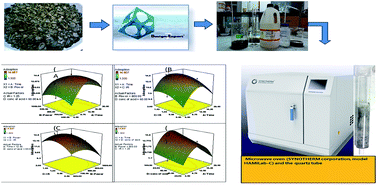Optimisation of the process variables in production of activated carbon by microwave heating
Abstract
This study aims to investigate the optimal operating conditions in order to obtain cost effective production of activated carbon (AC) from palm kernel shell (PKS) by microwave heating. Interactions among the independent variables, namely irradiation time (T), microwave power (W), impregnation ratio between impregnating substances and PKS, and the concentration of impregnating substance (sulphuric acid) were considered for optimising the process parameters during the production of AC, aided by Central Composite Design. The optimum conditions for the independent process variables were 11.02 minutes of irradiation time, microwave power of 676 W and impregnation ratio of 0.68. The AC produced in this work had a surface area of 1011 m2 g−1 with high porosity as shown by scanning electron microscopy (SEM). Zinc was used to verify the potential of AC as an adsorbent. Zinc removal at the optimum conditions was found to be 13.72 mg g−1. Such a Zn removal value is comparable with the earlier work of other researchers who used a conventional way of producing the AC. It is believed that microwave technology can be used for the production of AC in a short time with high energy efficiency, e.g., 11 minutes against 2–5 hours of reactivation for conventional methods.


 Please wait while we load your content...
Please wait while we load your content...